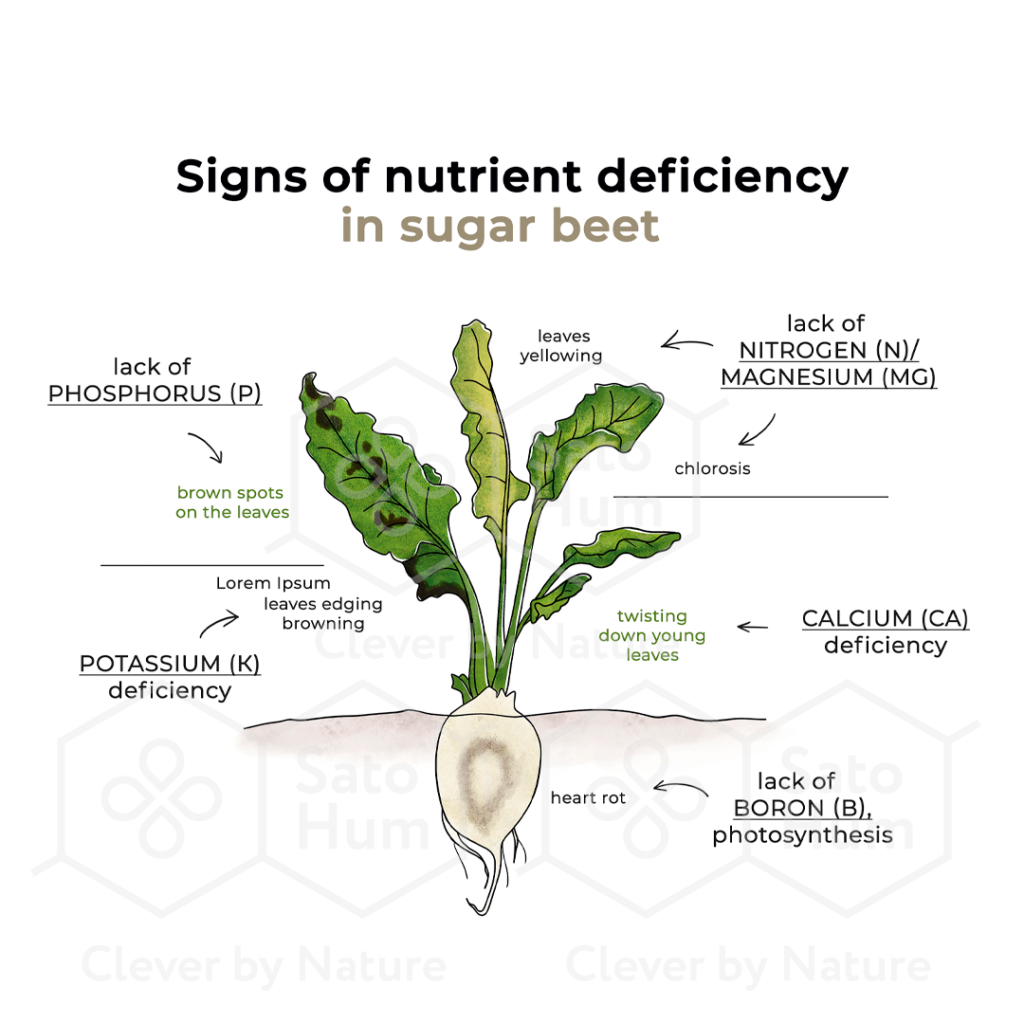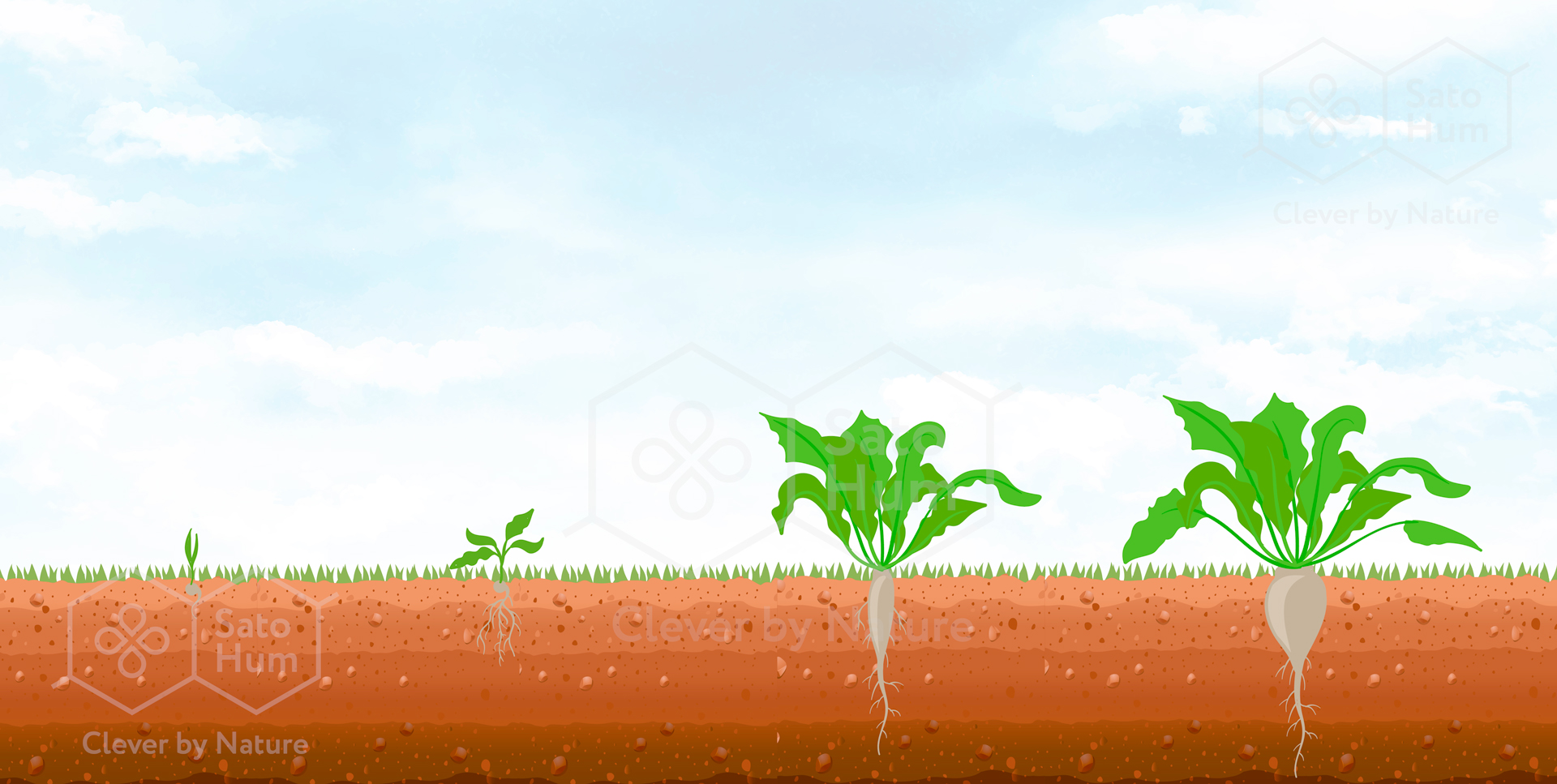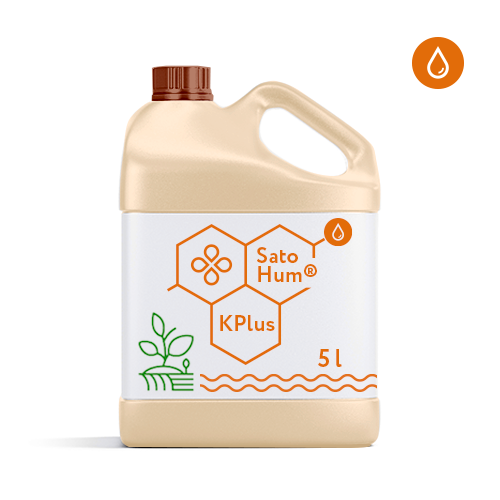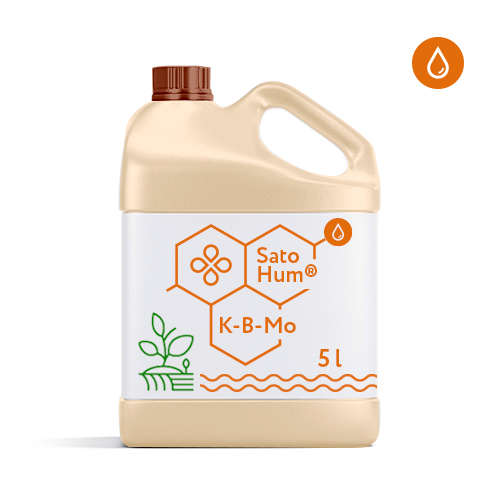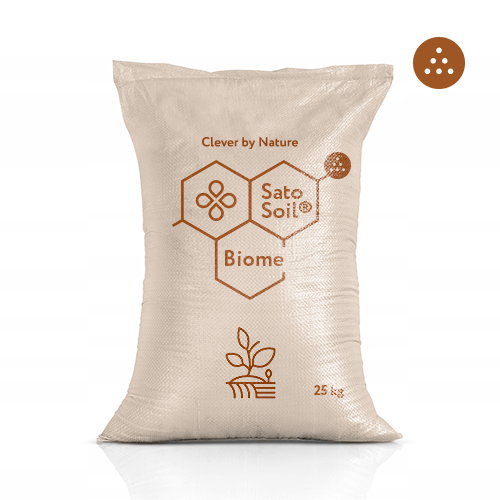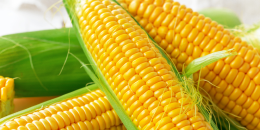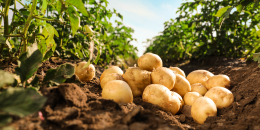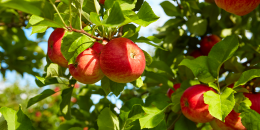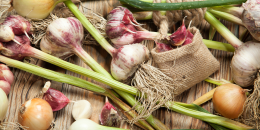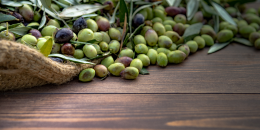Sugar beet is a rather capricious and traditionally industrial crop. Beets are demanding on the fertile soil layer, sensitive to field weediness and to predecessors. Sugar beet is not the most profitable crop, although it’s almost waste-free: root crops have industrial and table value, and tops and processed products of the sugar industry – sludge and pulp, are used in feeds and fertilizers.
Sugar beet
Good drainage and granulometric composition of soils in sugar beet lands is achieved by classical agrotechnological methods and reasonable crop rotation. To increase looseness, thermal and moisture regulation of soils, we recommend pre-sowing application of SatoSoil® soil improvers.
Soil improver SatoSoil® Biome has proven itself as a coating material for seed treatment, including in combination with Sato® Seeds natural disinfectant to guarantee unanimous even shoots of seeds suitable for sowing. When using other methods of germination and pre-sowing preparation, it’s recommended to use Sato® Seeds for seed disinfection.



The introduction of organo-mineral biostimulants SatoGrow® with a high content of humic and fulvic acids helps to avoid burns of the root system and excessive overfeeding of beets with minerals, promotes a prolonged release of macronutrients throughout the entire growing cycle.
Beet is a borophilic crop, therefore, the systemic introduction of this micronutrient into critical phenophases, namely during the formation of a root vegetable and growth to technical ripeness, is important. SatoHum® K-B-Mo and SatoHum® Ca correct essential micronutrient deficiencies and help plants reach their yield potential.
- leaves yellowing and chlorosis - lack of nitrogen and magnesium;
- leaves edging browning - potassium deficiency;
- insufficient green mass gain - lack of nitrates;
- brown spots on the leaves - lack of phosphorus;
- wrinkled leaves, twisting of young leaves down - calcium deficiency;
- heart rot - a sign of boron starvation, insufficient photosynthesis;
- hollowness and corking of the root - an excess of minerals in the root system.
Sugar beet is a rather capricious and traditionally industrial crop. Beets are demanding on the fertile soil layer, sensitive to field weediness and to predecessors. Sugar beet is not the most profitable crop, although it’s almost waste-free: root crops have industrial and table value, and tops and processed products of the sugar industry – sludge and pulp, are used in feeds and fertilizers.
Good drainage and granulometric composition of soils in sugar beet lands is achieved by classical agrotechnological methods and reasonable crop rotation. To increase looseness, thermal and moisture regulation of soils, we recommend pre-sowing application of SatoSoil® soil improvers.
Soil improver SatoSoil® Biome has proven itself as a coating material for seed treatment, including in combination with Sato® Seeds natural disinfectant to guarantee unanimous even shoots of seeds suitable for sowing. When using other methods of germination and pre-sowing preparation, it’s recommended to use Sato® Seeds for seed disinfection.



The introduction of organo-mineral biostimulants SatoGrow® with a high content of humic and fulvic acids helps to avoid burns of the root system and excessive overfeeding of beets with minerals, promotes a prolonged release of macronutrients throughout the entire growing cycle.
Beet is a borophilic crop, therefore, the systemic introduction of this micronutrient into critical phenophases, namely during the formation of a root vegetable and growth to technical ripeness, is important. SatoHum® K-B-Mo and SatoHum® Ca correct essential micronutrient deficiencies and help plants reach their yield potential.
- leaves yellowing and chlorosis - lack of nitrogen and magnesium;
- leaves edging browning - potassium deficiency;
- insufficient green mass gain - lack of nitrates;
- brown spots on the leaves - lack of phosphorus;
- wrinkled leaves, twisting of young leaves down - calcium deficiency;
- heart rot - a sign of boron starvation, insufficient photosynthesis;
- hollowness and corking of the root - an excess of minerals in the root system.
| SOILS | SEEDS | GROWTH | HARVEST | ||
| SatoSoil® Biome
Soil feeding after green manure Incorporation to a depth of 15 cm 5 – 10 t/ha Pre-sowing application on clean fallows 2 – 3 t/ha and abundant watering SatoSoil® pHoenix Correction of saline and acidic soils Fallows restoration, lands cultivation Deep plowing up to 18 cm 5 – 10 t/ha SatoHum® K or SatoGrow® NPK/ SatoGrow® N Watering the soil improver 2 – 6 l/ha |
Sato® Seeds
Planting material treatment Pre-sowing germination 20 – 30 ml/10 l of water Adding to the dragee mass 30 ml/1 kg SatoGrow® K Granules or SatoGrow® NPK Granules Targeted organo-mineral biostimulation 150 – 300 kg/ha/season SatoHum® K or SatoGrow® NPK/ SatoGrow® N Granulate activation 2 – 6 l/ha |
SatoHum® Complex
Complex top dressing of crops No more than 3 applications/cycle: 1 – 2 l/ha Last application no later than 3 weeks before harvesting SatoHum® K and SatoHum® K Plus Development of vegetative organs Green biomass growth No more than 3 applications/cycle: 1 – 2 l/ha Last application no later than 3 weeks before harvesting
|
SatoHum® K-B-Mo
Correction of micronutrient deficiencies 1,5 – 2,2 l/ha SatoHum® Ca Even weight gain of root vegetables 1,6 – 2,4 l/ha |
||
WARNING: 4 Sato® Steps is a comprehensive crop care system that provides the basic crop needs for the main 12 macro, meso and micronutrients for an optimal growing cycle and unlocking the potential of each crop.
SOILS: In pre-sowing application of SatoSoil® Soil improvers, the minimum rate is introduced, when autumn applying, the maximum rate is recommended. When applying SatoGrow® Biostimulants after SatoSoil® Soil improvers, the minimum rate is applied; if the soil hasn’t been treated, the maximum rate is applied. For irrigation, it’s recommended to activate granulates (soil improvers or biostimulants) with SatoHum® liquid formulations and SatoGrow® liquid organo-mineral biostimulants.
SEEDS/SEEDLINGS/VEGETATION BEGINNING: Treatment of seeds and seedlings with Sato® Seeds formulation is compatible with treatment by classical protectants without reducing the rates of their application, and helps to increase the viability of seedlings, the development of the plant and its fruitfulness.
GROWTH: Our SatoHum® solutions have a guaranteed composition with high content of humic and fulvic acids with amino acids of plant origin. It is not recommended to exceed the total applying dose of SatoHum® liquid formulations over 6 l/ha/season, starting from the germination/seedlings phase.
HARVEST: Simultaneous fertilization with several SatoHum® products is not expected. It’s not recommended to exceed the specified application rates. For single, not systemic application of SatoHum® products, the maximum dosage of the product is recommended.
